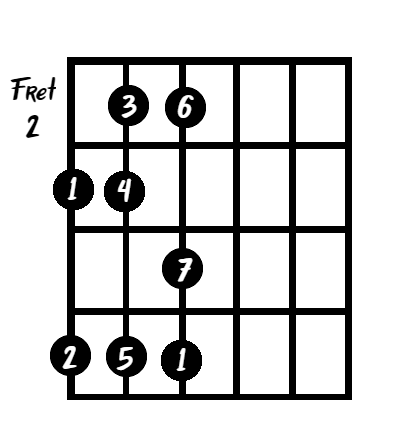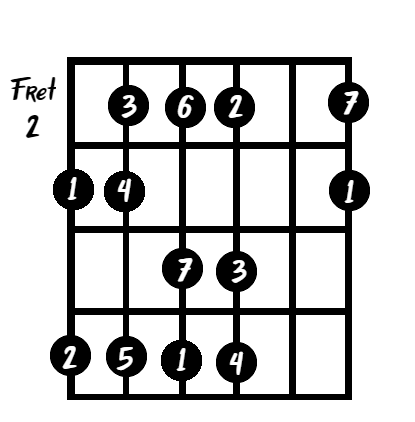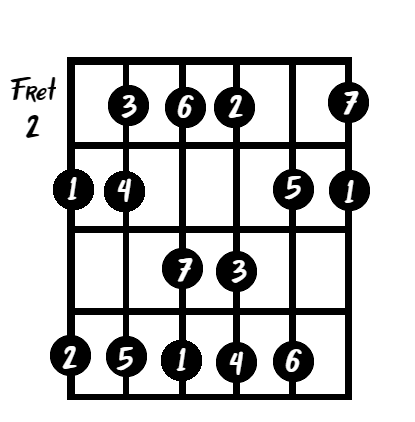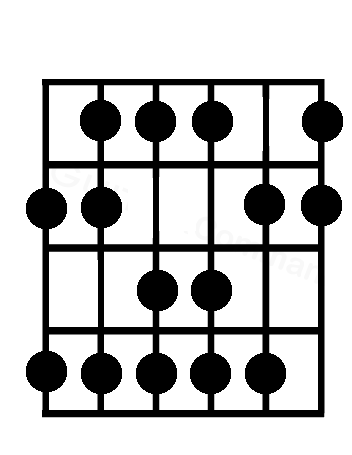
Knowing the major scale brings many benefits. If you understand the concepts, then you take a huge leap in your musical knowledge. But as a guitar player, you also need to know how to play the major scale on guitar.
But I don’t want to simply talk about the mechanics. Instead, This article walks you through using what you already know to build the major scale on guitar yourself so that you really understand why it works the way it works.
Memorizing the major scale on guitar is a complete pain in the backside. No one wants to do that. So instead of relying on memorization, in this article we’ll use your knowledge and logic to build the scale. This leads to the ability to memorize it naturally and simply because you completely understand it.
Don’t skip your pre reqs
To get the most out of this article, you must have a basic understanding of the major scale. If you don’t, then Understanding the Major Scale is Foundational Music Theory and Scale Degrees and Musical Intervals are required reading in that order! With that knowledge under your belt, let’s apply what you know to the major scale on guitar.
But first…the piano
I can’t help it…the piano is just so visual! So, let’s look at the piano keyboard to help us. Specifically look at the G major scale on the piano keyboard. Remember that only a half step exists between B (the 3) and C (the 4). And also just a half step between the 7 (F#) and back to the root of the next octave.

Important intervals to keep in mind
What does this tell us? Well, when you play the major scale on guitar, this tells you that you will skip a fret when moving from the 1 to the 2 and from the 2 to the 3. But from the 3 to the 4 you will not skip a fret. Similarly, from the 7 to the next octave’s 1 you do not skip a fret.
This very important piece of information will come in handy shortly as we start mapping out the major scale on guitar. So log that nugget of knowledge away. It’s true for the major scale in every key. Always.
Two planes to play in
On the guitar you can move along the neck in essentially two different planes. This creates an extra challenge for you as you learn to play. But it also makes the guitar an endlessly fascinating instrument.
Play the major scale on guitar horizontally
You can play the major scale on guitar up and down the length of the neck. Let’s call that the horizontal plane.
That’s similar to playing the major scale on piano. There you move right and left up and down the keyboard to get to the notes you want. You can’t play the major scale or any melody any other way on the piano.
Play the major scale on guitar vertically
But the guitar offers another option. You got a bit of a taste of this when we talked about tuning a guitar in my Let’s Talk More Deeply Than Just How to Tune a Guitar article. And if you haven’t read that yet, it’s a good idea to do it now because much of this article relies on what you learn there.
In that article we talked about how the 4th degree of the major scale sits at the same fret as the 1st degree–the root–on the string lower than it. Maybe you already considered that this means you can move up the major scale in another direction other than the piano-like horizontal plane.
Let’s call it the vertical plane. When you move along the vertical plane, you move across the width of the neck from string to string instead of along the length of the neck from fret to fret.
It’s not like you didn’t already know that you can move across strings
Of course, you obviously knew this the first time you saw someone play the guitar, but did you every really stop to consider it? Did you really stop to think about what it means and the ramifications it has?
If you’re like me, then honestly, no, not really. That’s OK though. It’s just one of those things that you don’t think about it because it’s logical. You see players do it all the time. You just take it for granted.
However, when you really stop to consider it, you start to gain true understanding of the instrument. So let’s consider it. And as usual, there’s no better place to start than with the major scale.
You can play the major scale across both planes
Just like any melody, you can play the major scale on guitar in either the horizontal plane or the vertical plane. Well, in reality, you can’t play the major scale on guitar in strictly the vertical plane.
That is, you can’t play the major scale on guitar just sticking to one fret and moving across all the strings. Of course, that’s logically obvious since there are seven notes in the major scale and only six strings on your guitar. And two of those strings are the same note (two octaves apart) at any given fret.
So, in reality, to play the major scale on guitar across strings (in the vertical direction), you actually need to move in both directions. You need to use different frets (the horizontal plane) and move along the vertical plane across strings at strategic times.
But you can do so with minimal movement of your hand up and down the neck. That’s because you can play the entire major scale within a span of any four frets.
A closer look at the major scale on guitar horizontally
Let’s review playing the major scale on guitar along the length of the neck. We’ll start with the G note at the third fret of the Low E string.
From the third fret we move to A at the fifth fret, B at the seventh, C at the eighth, D at the 10th, E at the 12th, F# at the 14th, and back to the next G at the 15th fret. And that’s the entire G major scale.
And we can play any other major scale up the length of the E string in the same way. Just start on the appropriate root note and follow the major scale pattern we already know.
Further, we can play the G (or any other) major scale on any of the other strings too. We just need to start on the appropriate root note for the scale.
For instance, we learned in the A Simple Pattern Can Help You Learn the Notes on a Guitar article that you can easily find a G note on the D string at fret 5. From there you can apply the major scale pattern to play the entire G major scale moving up the neck.
And don’t forget that you can also play the major scale moving down the neck, and thus down the major scale. Up and down on any string, you can play any major scale on guitar. Just start on the appropriate root note and follow the major scale pattern.
Easily find any note on the guitar with the pattern I discuss in my article A Simple Pattern Can Help You Learn the Notes on a Guitar
A closer look at the major scale on guitar vertically
But now, what about playing the major scale on guitar along the vertical plane–across the strings? Let’s see how it works.
Start again with the G note at the 3rd fret of the Low E string. But this time, play that note with your middle finger. This puts you in position to play horizontally when you need to as you move vertically across the strings.
You’ll end up using a four-fret span horizontally to play the major scale on guitar across strings. Remember; we have to use a combination of both planes to do this. In the case of the G major scale, you’ll use frets 2, 3, 4, and 5.

Look what you already know about the major scale on guitar
Think for a moment about what you already know about the guitar. We know that the G note one octave higher is on the fifth fret of the D string. We also know that the 4th scale degree sits on the same fret as the root note but up one string higher.
So, without even learning anything new, you can already identify a few key scale degrees.

And, because you know the major scale pattern, it’s also easy to understand that the 2nd degree is just two frets up from the starting fret. And that the 7th degree is one fret down from the root note an octave higher. So the seventh note–of course, that’s the F#–sits at fret 4 of the D string.
So, using a combination of knowledge of the major scale pattern, root note location, the location of the fourth, and simple logic, we can really start piecing things together to create the major scale on guitar.
Let’s lay out the entire major scale on guitar
We already know where the 1 is–the root–which in this case sits at fret 3 of the Low E string. And you’re using your middle finger to play that note. The 2 is A at fret 5 of the same string, and you’ll use your pinky to fret that note.
Now, playing the 3 on the same string would require us to move our hand to reach up to the B at fret 7, and since we want to play the major scale across the strings, we don’t want to do that. So we need to find the 3 on the next string up, the A string.
And logic makes it easy to find. We know where the 4–that’s the C–is. It’s at fret 3 of the A string. Remember, that’s the same fret as the root note one string higher. Works every time!
If you need help understanding the relationship between the 1st and 4th notes, read Let’s talk more deeply than just how to tune a guitar
And, we know from our scale recipe that only a half step separates the 3 and the 4. So that means the 3 has to be one fret down from the 4, which puts it at fret 2 of the A string. And sure enough, fret 2 of the A string is a B note. That’s the third scale degree in the G major scale on guitar and every other instrument!
And because you started with your second finger at fret 3, your pointer is comfortably in position to play the third at fret 2 of the A string.

So now you can easily play the first four scale degrees of the G major scale on guitar vertically. On the Low E string, play fret 3, then fret 5. Move to the A string and play fret 2 and fret 3. Those are the first four notes of the G major scale.
Of course, once you have the 4, you can easily apply the major scale pattern to find the 5 (that’s D in G major). Just skip a fret and play the D at fret 5 of the A string with your pinky.
Likewise,working backward from the seventh, skip a fret and play the 6 at fret 2 of the D string. The 6, of course, is E and that is indeed the note at fret 2 of the D string.
And now you have located the entire G major scale on guitar across the first three strings. And you never had to change your hand position in the horizontal direction.
The power of playing across strings
That’s part of the power of the guitar and knowing your instrument. It’s much more convenient to play the major scale on guitar with this pattern. Likewise it may be far more convenient to play melodies and lead guitar lines across the strings instead of constantly moving up and down the neck on one string.
In fact, playing just up and down one string is clumsy and silly in most cases. Sure; sometimes you’ll play a series of notes on one string. But you’ll definitely want to master moving across the strings to play fluidly and fast.
We can keep going another octave
But wait…you have still more strings to use! So far you’ve played one octave of the major scale on guitar moving across from the Low E to the D String. You landed on the 1 of the next octave at fret 5 of the D string. Why not keep going?

With the same combination of logic and knowledge, you can easily find the major scale from here. From your knowledge of guitar tuning, you know that the 4 sits at the same fret as the 1 only a string higher. So, fret 5 of the G string yields the D note which you play with your pinky.
One fret down from the 4 is the 3, so your C note is at fret 4 of the G string. And you can continue to work your way down and find the 2 at fret 2 of the G string.
You know that fret 3 of the High E string is the note G because it matches the Low E string. So fret 3 is the 1 of the next octave. You’ll play that with finger 2.
And naturally, one fret down from there is the 7 which is fret 2 of the High E string which you’ll play with your first finger.
The two hardest notes to find
So that leaves just the 5 and the 6 to find, and you probably already guessed that those are located on the B string. These might be the most difficult notes to find because of that pesky B string and it’s different tuning, but you know enough to work it out if you think about it.
You know that the 5 in the G major scale is D. And you also know that if you were in the key of A, the note D would be the fourth of the A major scale and thus would be located at the same fret as A, but one string higher.

Since you already found A (the second scale degree in the G major scale) at fret 2 of the G string, then you know the 4 of A (D) is at fret 3 of the B string. Remember you have to add one to the B string because it’s tuned to a third above instead of a fourth like the other strings.
And naturally the 6 of the scale (the E) sits two frets above the 5. So play the 5 with your middle finger at fret 3 and the 6 with your pinky at fret 5.
Now put it all together and you have the G major scale on guitar moving across the three high strings.
Combine what you know across all six strings and you find that you can easily play two octaves of the major scale on guitar without moving your hand position up or down the neck, but instead moving across all six strings.
Now you can play any major scale on guitar
And, of course, since you’re learning that the guitar is full of patterns, you can learn this pattern to play any major scale on guitar. Which scale you play simply depends upon which fret you start on.
All of our example images here show the major scale on guitar in the key of G major, but it’s moveable. Know it once, and you know it for all.
The notes of the scale will naturally be different, but the scale degrees are identical no matter what key you’re in as you play the major scale on guitar. That’s the beauty of knowing a little something about why it works the way it does!
Conclusion
How useful is it to know the major scale on guitar? How important is it to be able to play it in both the horizontal plane (up and down the neck on one string) and the vertical plane (across strings)?
Well, depending upon the style of guitar playing you plan to do and whether you’re playing lead guitar, you may or may not often actually play the scale like you’ve learned it here.
But that doesn’t mean you shouldn’t bother knowing this! Learn this pattern thoroughly. Play it up the scale and back down the scale. Over and over and over again until you really have it beneath your fingers without thinking about it.
And as you play it up and down, name the notes you’re playing and the scale degrees they sit at. This will have the side benefit of helping you learn to quickly identify which notes sit at which frets.
Doing so will give you a more complete understanding of your instrument. It will help not only in playing melodies and lead guitar, but also becomes invaluable when you want to find chords all over the neck.
And by the way; this isn’t the only way to play the major scale on guitar. There are several others. We can talk about those in future articles. But for now, learn this pattern. It’s a great start.

What a godsend!
I’m glad you found it helpful, Delta. Keep at it!